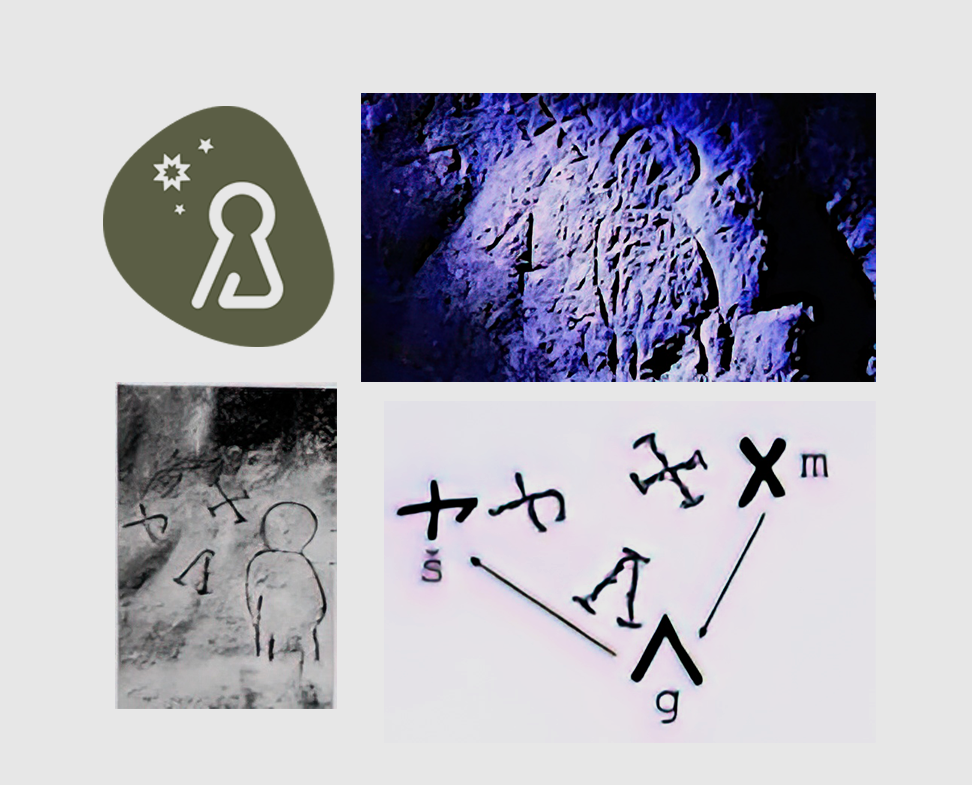
ABOUT THE LOGO
The logo combines two elements: a star and a human figure, inspired by the earliest known representation of a magi. It is located in Andalusia, in the Barranco de la Tinaja, in Otíñar, near Jaén. The archaeologist Georgeos Diaz-Montexano discovered it in a prehistoric open-air site. This trace is proof of the existence of the Magi in this region for thousands of years.
An original creation
The writings of the historians of Al Andalus confirm this presence of the Magi since prehistoric times. “The Magi, worshippers of fire, dominated the south of Spain well before the Phoenicians” according to Ahmad al Razi, a historian from Cordoba in the 10th century. For the historian Ibn Idari (11th century), a Moroccan of Andalusian origin, “It is claimed that the people who settled in southern Iberia after the flood were the Andalusians. It is also said that they were magi (magûs)”.
On the stone, three letters are engraved in Punic or Carthaginian script to the left of a figure. They represent the word mgš o mgsh (magosh) which means ‘magus’/ Magi.
On the stone, three letters are engraved in Punic or Carthaginian script to the left of a figure. They represent the word mgš o mgsh (magosh) which means ‘magus’/ Magi.
This inscription reminds us how much the rapprochement between East and West is rooted in the history of the peoples of Europe. It is part of the construction of European cultures and mentalities, notably thanks to the influence of the Phoenicians and Carthaginians since the 10th century BC.
The figure of a magi engraved on this prehistoric wall can be interpreted in various ways. Some discern an owl, a symbol of Greek wisdom. Others see the human form of a wise man facing the celestial vault.
The logo of the Magos Foundation is inspired by these interpretations. It can also represent the keyhole of a door that opens onto new horizons.
The figure of a magi engraved on this prehistoric wall can be interpreted in various ways. Some discern an owl, a symbol of Greek wisdom. Others see the human form of a wise man facing the celestial vault.
The logo of the Magos Foundation is inspired by these interpretations. It can also represent the keyhole of a door that opens onto new horizons.
ABOUT
THE EIGHT-POINTED STAR
It can be interpreted as the star of the Magi. It evokes the very first written description of this unusual star. The Syrian Ignatius of Antioch wrote it in the first century AD: “A star was seen to shine in the sky which made all the others pale: its brilliance was inexpressible, its novelty caused astonishment; all the other stars, together with the sun and the moon, followed it”.
In Christianity, the eight-pointed star becomes a double symbol: that of the Nativity and of redemption. It can be found in the architecture of many octagonal churches. The eight-pointed star is known as the Star of Andalusia. It is often found in the architectural decorations of Al Andalus and reminds us that East and West are able to live together peacefully. This sign can be found in Hinduism, which the magician Gaspard of India is said to have practised. In these countries, it represents the eight forms of the goddess Lakshmi.
The eight-pointed star is drawn on some flags of countries strongly associated with magi, such as Iraq, where the prophet Daniel (nicknamed the magi Balthazar of Babylon), a Jew deported to Babylon, lived, or in Azerbaijan, where the magi Melchior is supposed to have come from. It is also a symbol of the Arabic alphabet and marks the end of a chapter in the Koran. On the African continent, where the magician Balthazar is said to have come from, the eight-pointed star is found in ancient Egypt.
Copyright © 2022 Fondation Magos. All rights reserved

